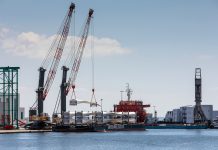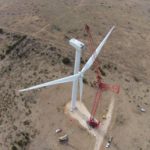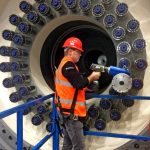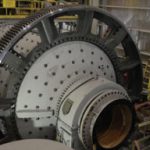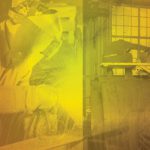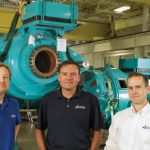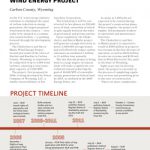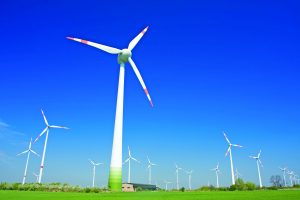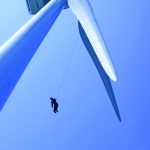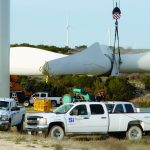Wind-turbine parts are big. So it only stands to reason that moving those big parts to their final destination would be a big job.
Planning, coordinating, and constant monitoring are essential when moving massive wind-tower sections and blades across the country. A missed calculation could equal big problems for cargo moving through rural America.
The experts at Logisticus Group manage the complexities of transporting massive wind-turbine parts, making sure every project or move begins and ends without a glitch. And they do that with a heavy dose of technology.
“Our goals are to bring technology to the traditional transportation industry, to create new services that are growing and evolving as the wind-energy market evolves, and to bring a new level of service that the industry has not truly been accustomed to,” said Logisticus Group CEO Vikash Patel.

Technology is Key
Patel said Logisticus saw a gap in the transportation market where the introduction of technology, as well as a specific skill set, could fill a void in the wind industry.
“With all of our services, including GPS tracking, we measure data through the use of online systems and turn around and push out customer dashboards, so they can understand performance levels, inventory levels, and KPIs (key performance indicators),” he said.
KPI examples include crane efficiencies, truck efficiencies and rail efficiencies, measuring the operations in real time. Logisticus provides that information to stakeholders as it’s collected, according to Patel.
“Changes and decisions can be made in real time versus looking at everything at the end of a project and coming up with lessons learned for the next project,” he said. “We’re looking for real-time change.”
As turbines continue to increase in size, Patel said turbine transportation must include more preparation before those parts even come close to hitting the road.

Upstream Planning
“There’s very little we can do to impede the growth of a turbine,” he said. “That’s market driven by market demand. As they’ve gotten bigger, it requires even more upstream planning — working with the local authorities and working with the customers to ensure roadways are going to be capable of handling these types of larger blades specifically. In short, working upstream with the Department of Transportation, the customers, and the local authorities to make sure there’s not a problem when it comes time to ‘turn the faucet on,’ and working with them to improve turning radiuses or to determine routing from point A to point B without any damage.”
Logisticus is now handling projects that involve re-powering, which often includes disposing of or recycling older wind-turbine blades as they are removed from obsolete units or are replaced as turbines are upgraded for larger megawatt output.
“We also just opened up a warehouse in Iowa, which is a distribution center where we’re refurbishing fixtures that are used to transport towers, blades, etc.,” Patel said. “And the newest is our rail division where we have engineering and operational expertise to help support our customers’ rail operations when it comes to transporting turbines to wind farms.”

Approaching a Project
Projects may be complex, but Patel said Logisticus’ initial approach to them isn’t.
“We follow a fairly simple Six Sigma type of process where we go in first to see exactly what we’re looking at,” he said. “We assess the specifications, what our thresholds are, and what resources are required.”
The actual planning phase involves going out to physically understand how all the components can move from point A to point B, according to Patel.
“Once we’ve determined a route, we work with both state and local authorities to help them understand what kind of an impact it’s going to have on essential roadways and to get their feedback on how we can most successfully move this without a negative impact,” he said. The execution stage comes next.
“We use a lot of technology in the form of computer-assisted software that we build in-house, including GPS units, to ensure the most
real-time data and information is available to all stakeholders,” Patel said. “We’re trying to minimize the use of phone calls and emails through the relay of real-time information. Once we put those systems in place and start the execution process, it’s execute and measure, execute and measure. The big takeaway is to try to understand potential pitfalls, so in enacting real-time changes, we can minimize the project getting off track and look at leading trends that may indicate whether problems may arise.”

Specialized Tech
That technology is essential in making sure a project goes smoothly, and Patel said that is a specialty of Logisticus.
“As part of Logisticus, we have a company called Logisticus Technology Solutions, where we specialize in building 100 percent customized software solutions that are contoured and created for each individual project,” he said.
Demands can differ from customer to customer and from project to project, so Logisticus takes that spectrum and crafts software to meet specific needs.
“We try to build systems that don’t have any unnecessary clicks or fields that don’t pertain to the project, and ensure that the system is turning around and providing a dashboard with KPIs and GPS data that’s valuable to our customers,” Patel said. “We have coders in house that literally build everything from the ground up. So we sit down with customers and try to understand what they are looking for and what information is important to them. And that turns into our blueprint, and the coders go to work building the software.”
Taking Notice
And Patel said the industry is starting to take notice of what Logisticus can offer.
“Customers have started to really see the value in using Logisticus when certain needs or services don’t necessarily fit well into any specific bucket,” he said. “We really pride ourselves in being able to take a need, understand it, put a process around it, and then operationalize and measure the data. We create unique solutions that are very transparent. That’s not something that everybody necessarily does.”
A growing industry need is in the transportation of transformers that take power and put it on the grid.
When these transformers are damaged by lightning, they must be replaced as quickly as possible in order to keep the power flowing.
Typically, it can take six to eight weeks to get a new transformer to its final location. That turnaround often includes Department of Transportation permits and other issues.
“We’ve been able to drive that lead time down to as little as one to two weeks,” Patel said.
And depending on the location, that reduction in delivery time can translate into millions of dollars saved for the customer, according to Patel.
Young Company
Logisticus is a fairly young company, having started in 2012 by a group who worked with General Electric in its wind-energy division.
“We’re pretty unique in the market in that we’re all pretty young,” Patel said. “We are probably the youngest entrepreneurs in the logistics market for wind.”
But Patel said that youthfulness can be an attribute in wind.
“I feel like our youth allows us to more easily adopt technology to what has been a fairly traditional market, which has had little technological change over the past 30 or 40 years,” he said. “We really are proud of not just growing ourselves, but growing with an industry that’s moving at a pretty fast pace.”
Logisticus will be at AWEA’s WINDPOWER 2017 in Anaheim, California, and Patel said he hopes people will check them out and see what the company has to offer.
“We’ll be featuring a lot of information about our new services, such as our rail division, drone and aerial mapping capabilities, and government planning that we really want our customers to come and ask about,” he said.

















